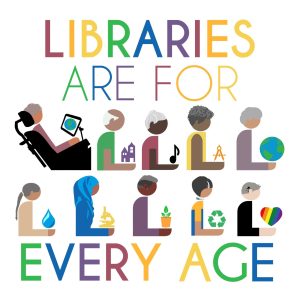Reflection Blog: New Models – Banishing Old Ideas of What Libraries Should Be
Part of why I love being in this program, is learning about and exploring ways in which library and information science is evolving. One of my favorite things I’ve learned about is the organization UXLibs – which I found when I did a topic exploration for INFO 202. UXLibs is an organization that focuses on exploring what UX looks like in libraries, how it can be incorporated, and resources to educate current and future information professionals. They hold a conference every year – where they spend a weekend exploring a particular topic of UX and how it can be incorporated into libraries. This week’s topic brought this conference to the forefront of my mind again and I truly hope I will get to attend one day.

Logo from UXLibs website
That being said, I would like to continue my exploration of space and how it relates to new library models. We have begun to see this trend where new library spaces are not simply people built with books in mind – we are beginning to see these spaces, shaped and formed, by the users of the library in mind as well. Space is intentionally shaped to project a certain atmosphere and feeling that invites the library user into the library and feel welcome and a part of the space – not simply existing in it. This is why UX practices would be so beneficial when designing library spaces.
For the most part when people consider UX – it is often in the context of navigating digital spaces like websites, forums, and digital messaging tools. UX, however, belongs in the design of physical spaces as well. And this is not a new concept, buildings and spaces need to be built with ADA accessibility accommodations in mind and UX expands on this – I like to think of UX as a more encompassing way of creating spaces that are accessible and functional. By creating libraries with these things in mind – we are able to invite in a wider population of users and ensure that everyone feels welcome within the space. We want patrons to feel like we see them.

Niños Conarte Children’s Library in Monterrey, Mexico. Image from Library Journal
These considerations can be something that is simple as wider walkways and spaces between stacks for individuals who may need mobility aids to get around or something out of the box and innovative, like transforming the stacks in a children’s area to an explorable space that can be climbed on, in, over, under, and around. I particularly liked this idea because it incorporates this idea of physical exploration and play within the library space that can go hand in hand with literary exploration. Cater the space to those are going to use it most – why shouldn’t a children’s area be able to be explored this way? This further breaks the mold that the library is only for the bookworms or the scholars – libraries are for everyone. Plain and simple. And to show that we need to build and model our libraries to reflect that.

2 Comments
Kristin Hirst
Hi Ashley!
I enjoyed reading your post. I agree that it’s so important to create a space with an atmosphere that will be inviting and make users feel a sense of comfort and belonging. You made some great points about UX and the way it can go beyond navigating digital spaces and be used to design the physical space in a library. This seems like such a powerful way to create a space that’s designed with our users in mind. Thanks for sharing!
Michael Stephens
@ashleyho I am so glad you chose to reflect more on library spaces and for this post UX. I think this is very important for spaces that we make available to the community we serve. I appreciate your thoughts on creating the space for the various types of folks that will be using those spaces from children onward. So nice to see the libraries are for every age graphic as well. I have never seen that.